From the moment I learned of the existence of Hector’s dolphins, seeing these creatures in the flesh shot straight to the top of my wildlife-encounter bucket list.
Not only are they the smallest oceanic dolphins in the world – they come complete with adorable black-and-white markings and perfectly rounded little beaks and dorsal fins.
These cute cetaceans live only in the coastal waters of Aotearoa New Zealand’s South Island and the best place to see them up close is in beautiful Akaroa Harbour on the Banks Peninsula, 75km southeast of Christchurch – which is where I am today, about to board a boat to hopefully see some Hector’s in the wild.
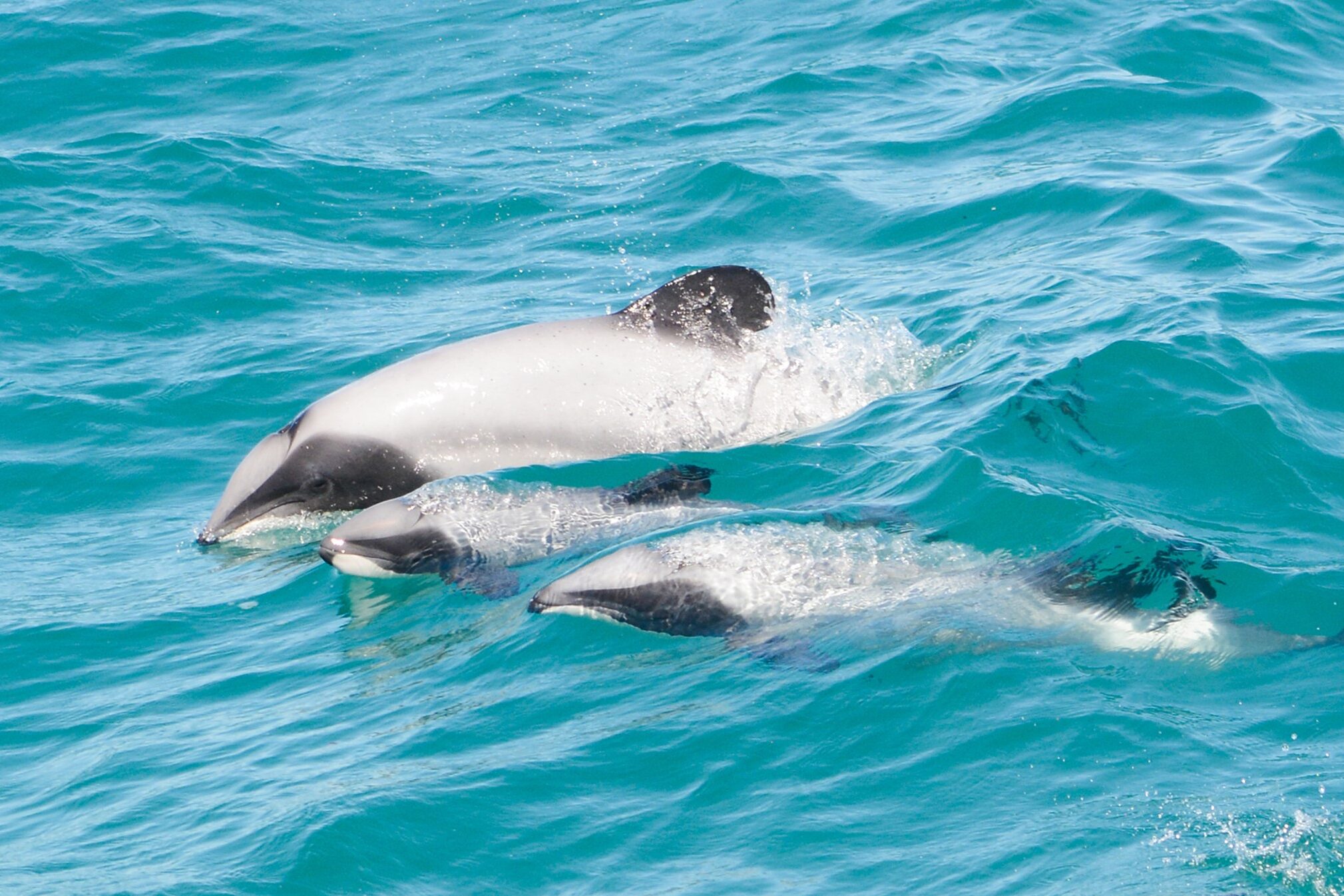
Boarding the Akaroa Dolphins catamaran, my fellow guests and I are greeted by the crew but instantly distracted by an unexpected team member – a gorgeous springer spaniel kitted out in a custom-fitted bright-orange doggie lifejacket.
Once seated on board, a friendly voice beams over the loudspeaker, and we soon learn that the dog’s role in this tourism operation goes far beyond charming guests. “Hi, I’m Chops, your skipper. Also on board is our guide, Charlie, and our dolphin-detection dog, Albie.” (That’s not a typo. Our skipper indeed said ‘dolphin-detection dog’!)
As the jetty and the small, picturesque township of Akaroa disappear from view and Chops steers the boat out of French Bay and into the open waters of Akaroa Harbour, I pay the cockpit a visit to quiz him further about Albie.
“He’s probably one of our best,” says Chops (full name Charles de Lambert), explaining Albie is one of a group of dogs that take turns going out with the boat, helping to find the dolphins. “He gets really excited and puts his snout out over the bow of the boat when they are close.”
It turns out each dog has a different ‘tell’, displaying different body language when they sense dolphins are nearby.
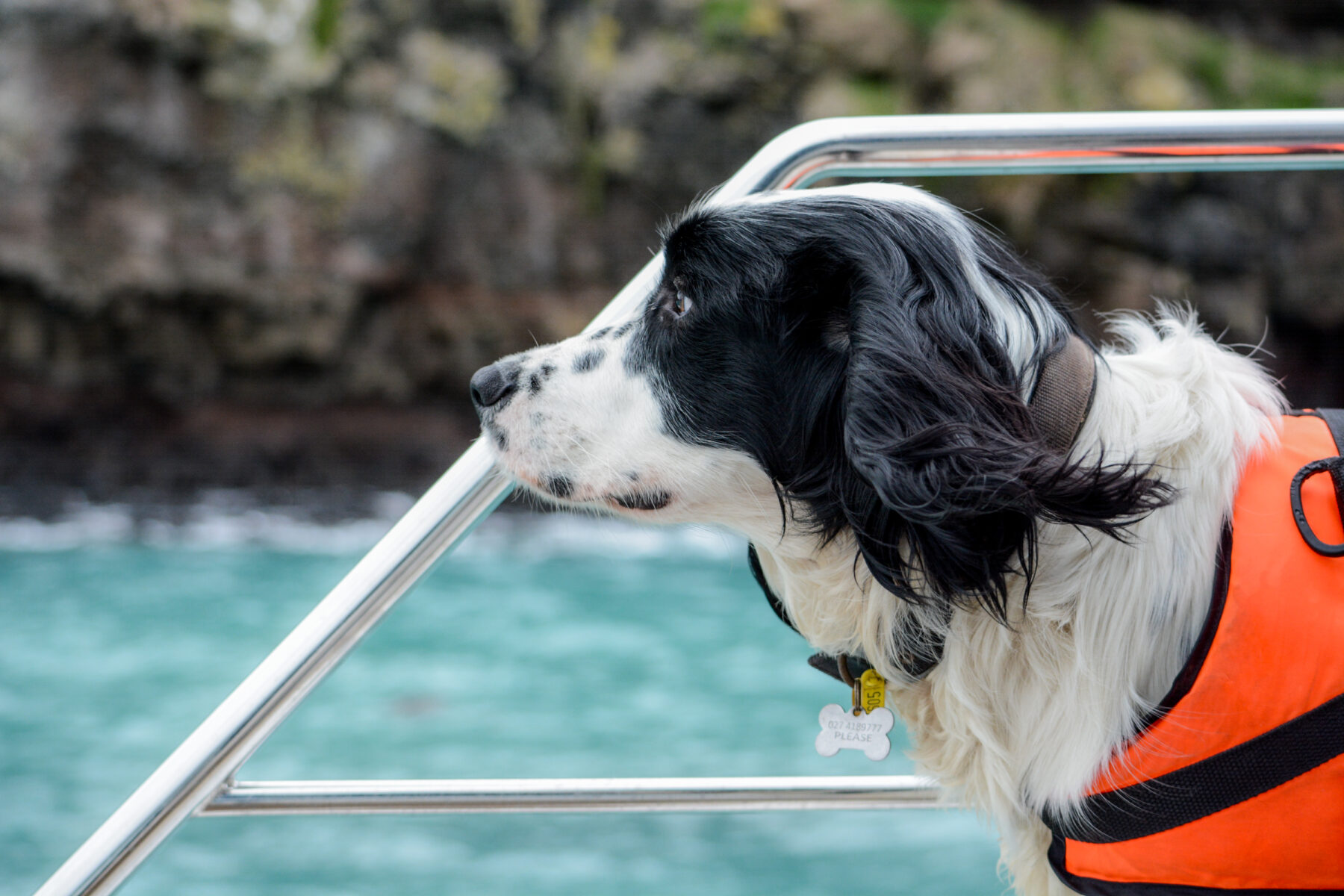
Later I meet up with another (human) member of the Akaroa Dolphins team, Julia Waghorn – the eldest child in the family-run business – who gives me more details about the doggie squad.
“There’s Albie, Buster, Jet and Jimmy,” she says. “Albie is obsessed and leans over the front, getting right down on his belly, whereas Buster scatters or runs around from side to side and Jet will bark, which is not ideal. My dog, Jimmy, is still in training – he hasn’t really noticed the dolphins yet!”
But it all started with Hector, the family’s very first ‘dolphin dog’. And it certainly wasn’t something they planned.
Pip and Hugh Waghorn (Julia’s parents, who started Akaroa Dolphins) lived on a farm for 23 years before making the permanent move to the seaside to start the business.
“On the farm they had lots of sheepdogs and, when they moved to Akaroa, they wanted another dog – so they got a Cairn terrier and named him ‘Hector’, after the Hector’s dolphins,” explains Julia.
“Dad started to notice on the boat that when dolphins were close, Hector would pace back and forth along the side.”
The rest, as they say, is history. Hector may have since retired but his legacy lives on in the current crop of dolphin-dog recruits.
Of course, the dog’s skills have never been put to the test in any official way; Julia is quick to note, “They’re not trained like airport sniffer dogs, but they have heightened senses that humans don’t have. Their body language clues tell us there must be dolphins around.”
Meet the doggie squad
Hector’s dolphins use echolocation to navigate their surroundings, emitting short, high-pitched clicks far beyond the human range of hearing.
“They are what we call ‘ultra-high-frequency hearing cetaceans’,” says Anton van Helden, who has been working with Hector’s dolphins (and the Maui subspecies) for 35 years. He is currently a Marine Species Science Advisor at New Zealand’s Department of Conservation (DOC).
“So they produce most of their sound, we assume, in and around 125-130 kilohertz (kHz) – that’s really high, it’s well above our hearing range.”
The human hearing range averages at a maximum of 20 kHz. It’s well documented that dogs can hear pitches much higher than this, but whether they can hear the clicks of Hector’s dolphins is yet unproven.
Regardless, Anton says, while it might not be proven by science, “There is something going on” with the dolphin dogs.
“I don’t know it is, but it’s wonderful to see, it’s extraordinary,” he says, before throwing an additional theory into the ring:
“Dogs can also smell extraordinarily well, so it may not be hearing. Dolphins slough their skin so there may be discrete amounts of oil in the water that the dogs are picking up on. Who knows? But I think it’s fascinating.”
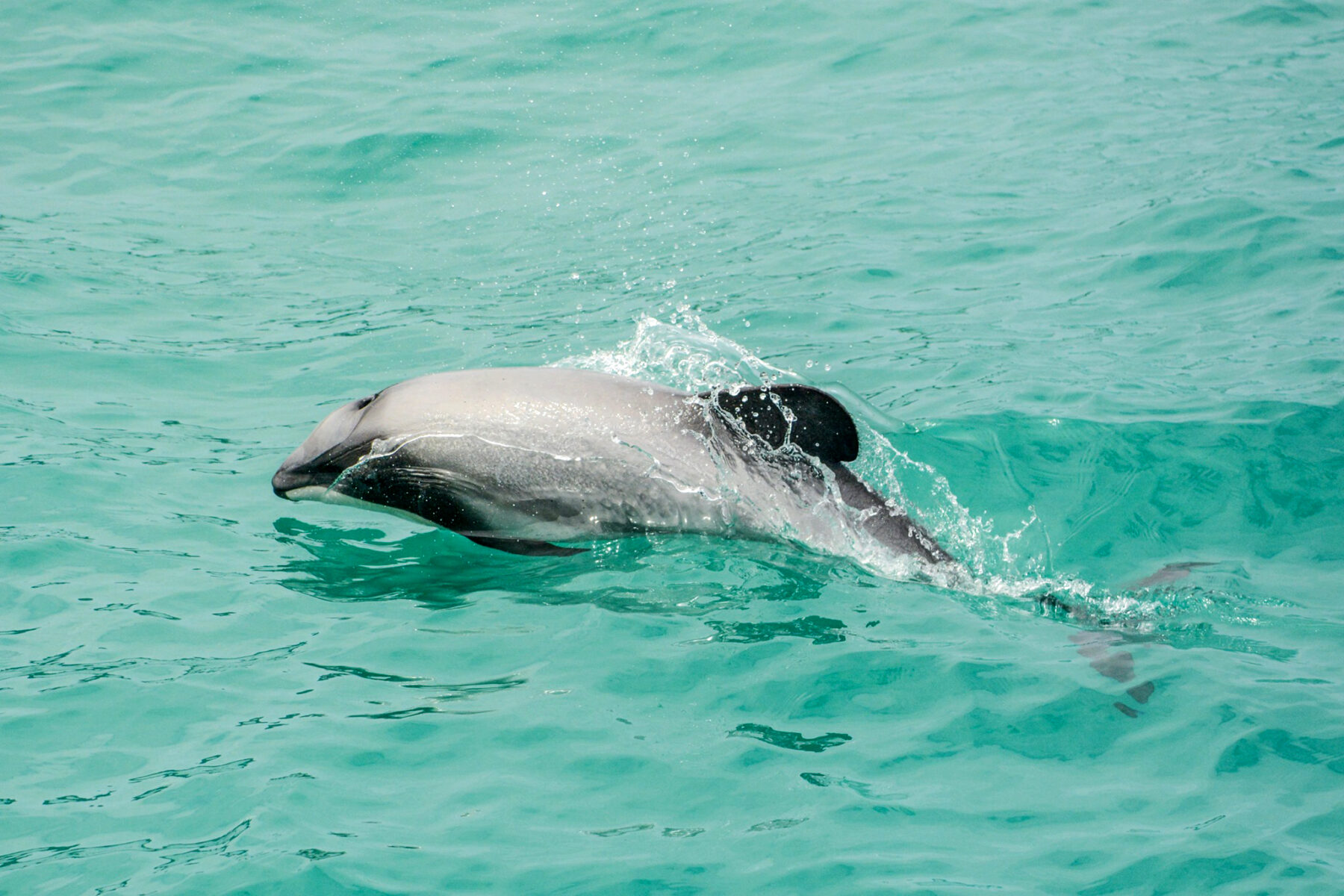
Julia is equally impressed by the dog’s abilities. “It’s a beautiful thing to see,” she says. “Although sometimes they like pats and cuddles more than spotting the dolphins!”
Which brings me back to the boat, where Albie is doing exactly this. After lapping up the attention, he finds a sunny spot on the bow and has a lie down.
“He just got back from holidays, so he’s easing back into the job,” says Chops.
If you can call this a ‘job’ – the view from Albie’s ‘office’ is divine. And I’m told today is as good as it gets out here on the harbour – clear and sunny, with calm blue water and hardly a puff of wind. Surrounded by steep bluffs and tall cliffs plunging into the water, you’d be forgiven for thinking we’re cruising through one of New Zealand’s iconic deep fjords, but we are actually in the flooded crater of an extinct volcano, with the channel reaching a maximum water depth of only 13m.
“That suits the dolphins,” Chops tells me.
This is because Hector’s prefer shallow coastal waters – spending most of their lives within the 50m depth contour and travelling only as far as 22 nautical miles (40.7km) offshore.
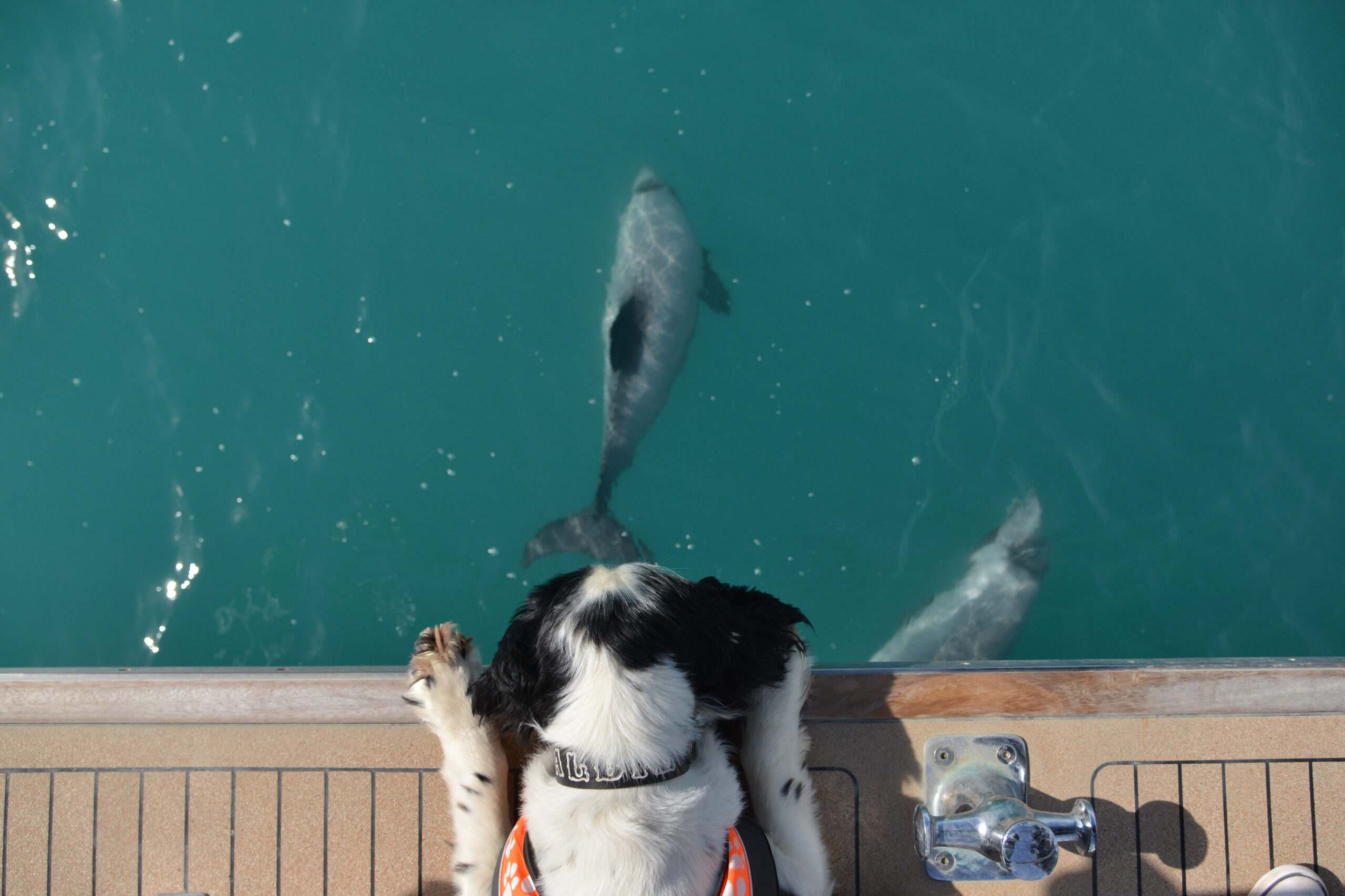
“They seem to prefer shallow turbid water, as this may give them a competitive advantage, in that they have some protection from visual predators,” says Anton. “And because they are echolocating dolphins that use bio sonar to hunt for food, this cloudy water is not an issue for them.”
Sub-populations also remain in the one area, he adds. “They don’t move much. For the most part they have constrained home ranges. If they do move it is only 50 nautical miles here and there.”
This means the Hector’s here in Akaroa Harbour are true locals, spending their average lifespan of 20 years in these waters.
Meanwhile, just when I am thinking these locals are taking a while to surface to say hello, a pod appears portside. Albie leaps from his slumber and joins the flurry of excitement of everyone on board.
The four adults, each measuring around 1.5m in length from nose to tail and weighing in at a tiny average of 50kg, are adorable little pocket rockets jumping in and out of the water like boisterous acrobats. Apparently they perform stunts when trying to attract a mate.
Their bright white bellies and chins glow in the sunshine, in stark contrast to their jet-black tails. But perhaps my favourite feature is what looks like a black eye mask, the marking continuing down to their flippers.
I look over to Chops, his facial expression a mix of delight and relief, having delivered the experience everyone, gathered on a boat in this remote corner of the world, was here for.
“It never gets old,” he says to me, as the dolphins disappear beneath the surface, and we all begin to regroup.
And that means a lot coming from Chops. Hector’s have long been a big part of his life.
“I haven’t been working long as a skipper for Akaroa Dolphins,” he says, “but I have been out on the dolphin boat for probably 65 or 70 trips.” He has also been diving, fishing and boating in Akaroa for decades.
“I can remember way back being right at the top end of the harbour, taking one of my daughters waterskiing, and the dolphins were surfing the wake next to her,” he recalls fondly. “I have three daughters, and they all love the sea and this whole area, and now one of my daughters brings her daughters out on the boat with us – so they’re now experiencing the dolphins.”
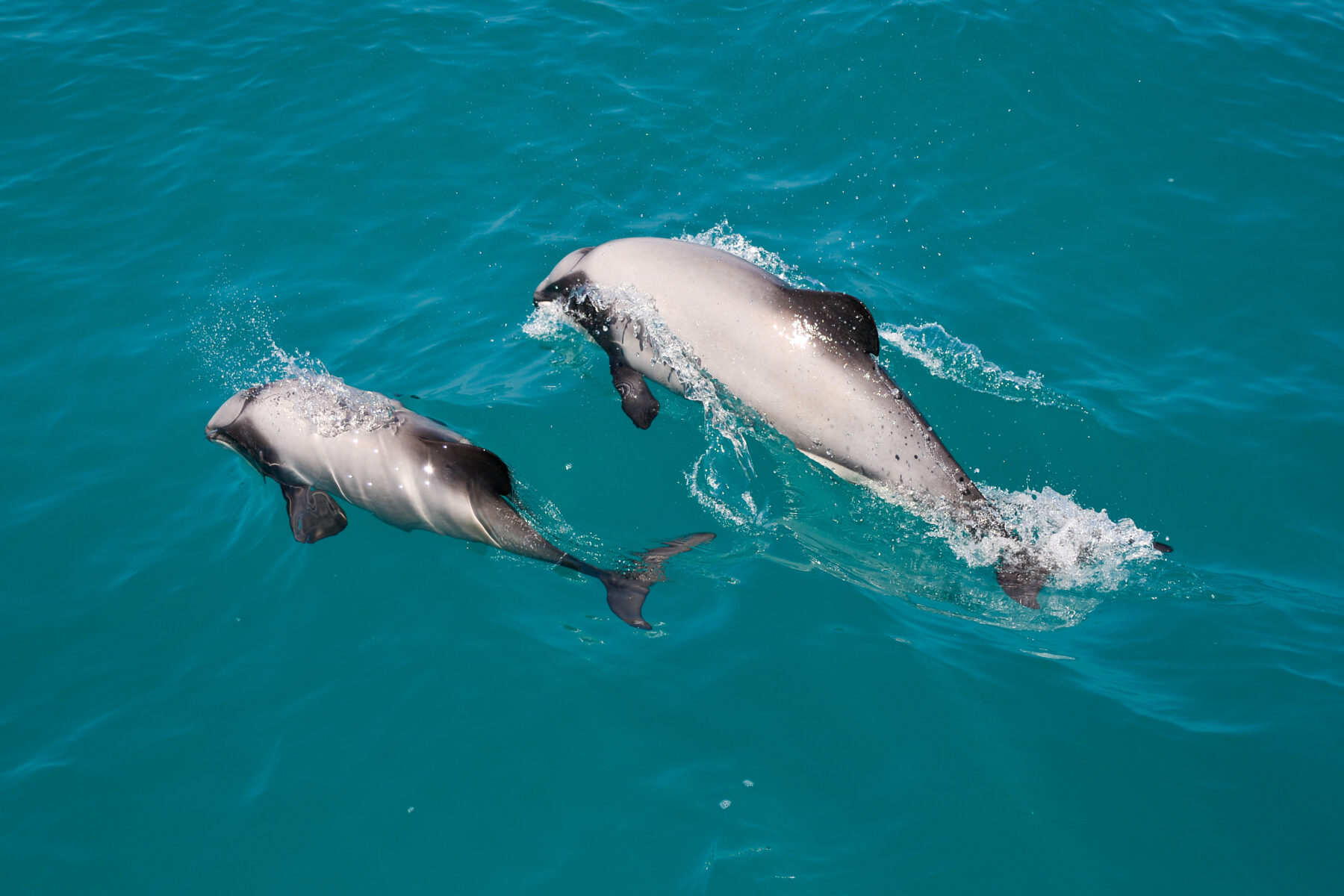
I ask Chops his favourite thing about the Hector’s. He tells me it’s the way they seem to smile. He is also fascinated by the clicks of their echolocation. But it’s the calves that have clearly stolen his heart, the size of a rugby ball when born.
“They are not very good swimmers, and their mothers need to kind of nuzzle them to the surface to take their first breaths and to keep them afloat while they get their breathing sorted. Instead of seeing the usual graceful dolphin re-entry into the water, you get a very awkward sideways belly flop,” he says with a laugh.
“Often I’ll hear a splash and look over and see it’s a baby dolphin learning to swim – clumsy little dolphins!”
Balancing tourism with conservation
Beyond the doggie-and-dolphin cuteness overload there’s a serious side to this experience. Hector’s dolphins are classified as Nationally Vulnerable under the New Zealand Threat Classification System (NZTCS), with an estimated 15,000 individuals remaining. The Maui subspecies is ranked as Critically Endangered, with just over 50 individuals documented.
Although once thought to have been abundant in New Zealand waters, Anton explains there is no accepted historic estimate of population size. “We have no actual basis from which to determine historic population sizes, or trends,” he says.
“Although it is clear that the dolphins have been impacted by threats – particularly from the 1970s through to the 1990s from set nets, monofilament nets, and trawl fisheries.”
Since then, a lot of work has been done across multiple agencies and multiple levels of government to build and stabilise populations.
As well as fishing restrictions, bans on seismic testing and dolphin interaction legislation, there are also now two overlapping marine protected zones within Akaroa Harbour – the Banks Peninsula Marine Mammal Sanctuary (established in 1988 and expanded since), and the Akaroa Marine Reserve (established in 2014).
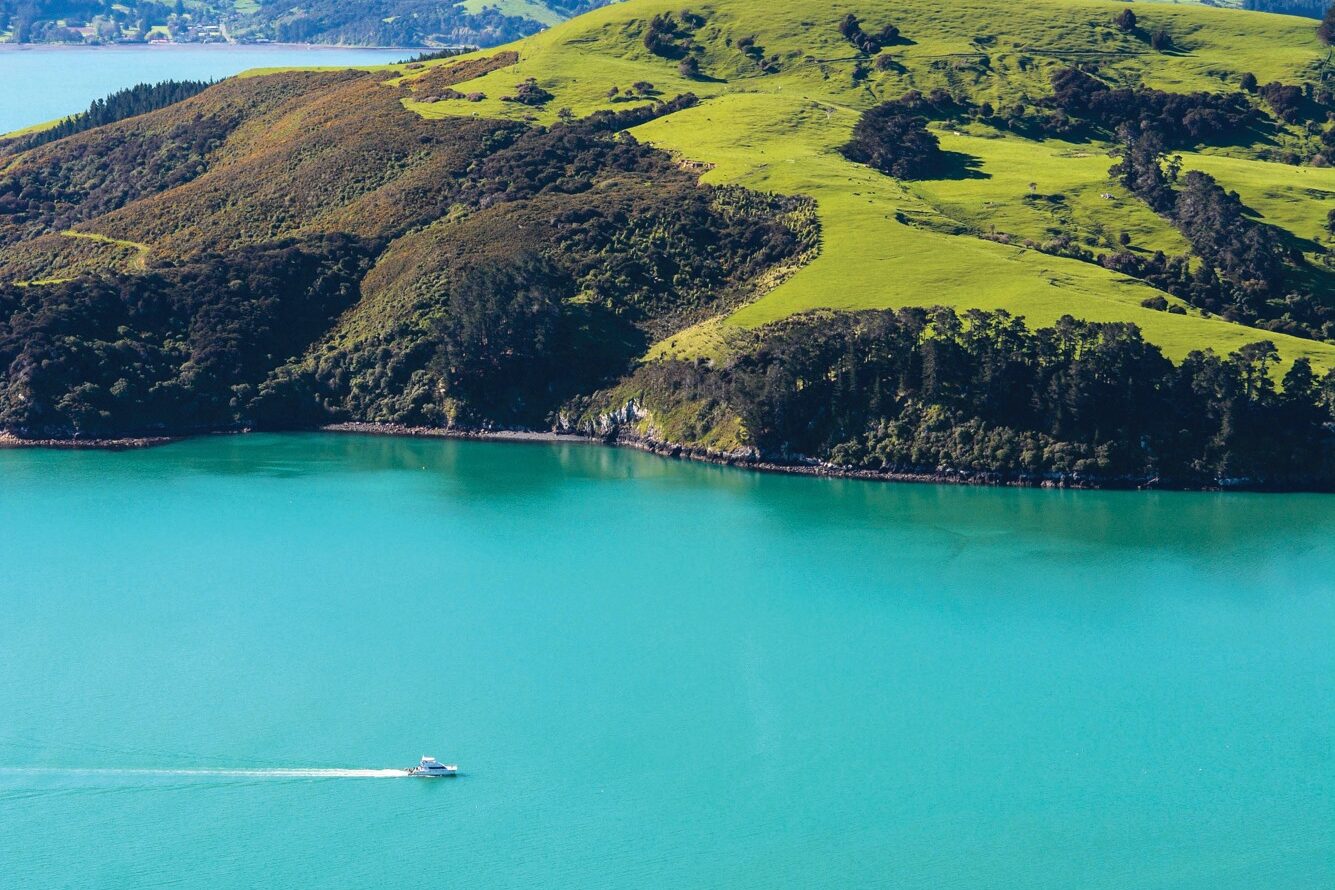
Today, the remaining threats facing Hector’s dolphins are both natural and man-made. The species breeds slowly. Females don’t have their first calf until the age of seven or eight, with a new single calf only every two to four years. They also have a lifespan of up to 25 years, which is short compared with other dolphins and whale species.
Human-induced threats include fishing and bycatch, boat traffic/noise and strikes, oil and gas exploration, seabed mining and acoustic seismic survey work and toxoplasmosis (a disease spread through the faeces of feral cats).
Also included in the list of threats is tourism, which is where responsible operators like Akaroa Dolphins play a major role in the conservation of the species.
“People want to go and see the dolphins and they’re not thinking that their presence may be disturbing to those animals,” says Anton. “That’s why we need regulations in place to protect them.”
Some of these regulations include limiting speed and boat numbers, and training and accreditation of boat operators. Akaroa Dolphins also works closely in collaboration with DOC to responsibly manage their interactions with the dolphins. The team also collects data for research projects and are even trained as ‘mammal medics’ to be able to assist in the rescue of stranded whales and dolphins.
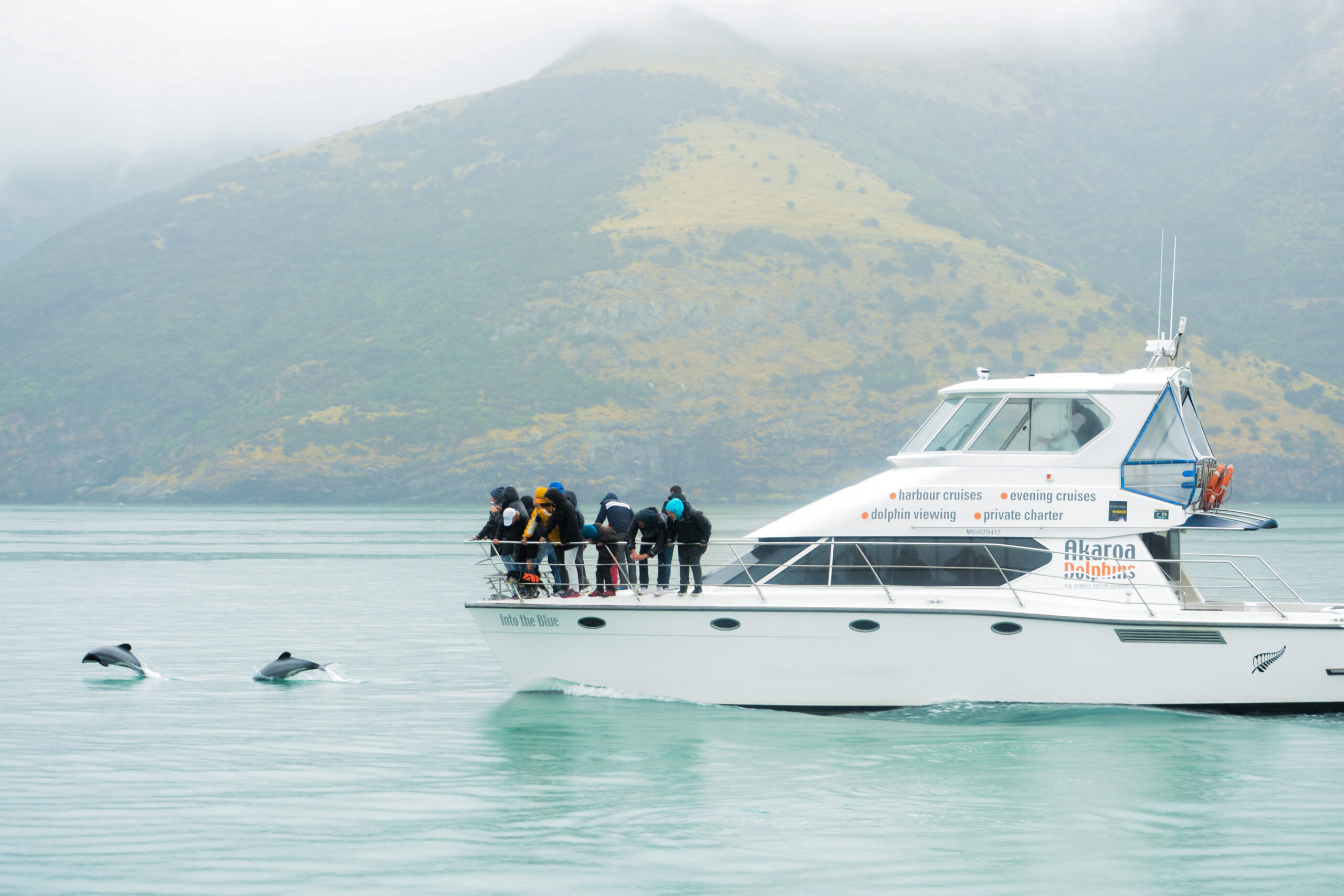
Hugh and Pip Waghorn are also key members of the Akaroa Marine Protection Society – the group that fought long and hard for the Akaroa Marine Reserve.
“The Akaroa Harbour Protection Society was formed almost 20 years ago,” explains Hugh. “Its aim was to have a marine reserve in Akaroa Harbour. The first marine reserve application was turned down and we spent the next 17 years fighting various governments. We raised around $40,000 to fight the decision and finally achieved the new marine reserve in 2014.”
Then there’s the power of awareness. There’s a famous David Attenborough quote: “No one will protect what they don’t care about; and no one will care about what they have never experienced.”
This is possibly the best argument in support of any wildlife encounters offered to tourists – and what Akaroa Dolphins offers is no exception.
“We get huge pleasure and huge satisfaction being able to share the dolphins and this special piece of the environment with people from around the world and seeing people’s delight,” says Chops.
“It’s a good conservation story and I think the strongest message we can give to our guests is that conservation is great.”
Candice travelled as a guest of Ōtautahi Christchurch NZ.
All imagery courtesy of Akaroa Dolphins.



